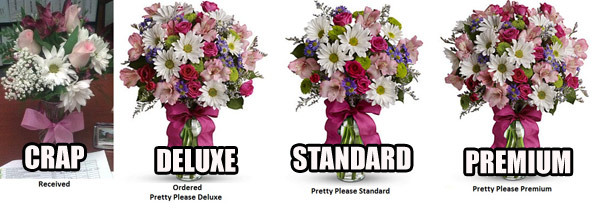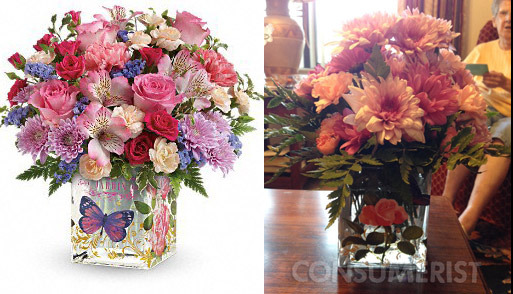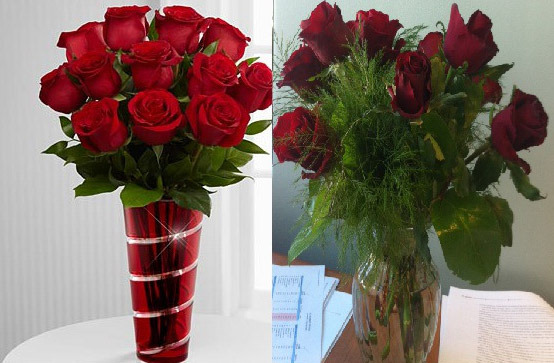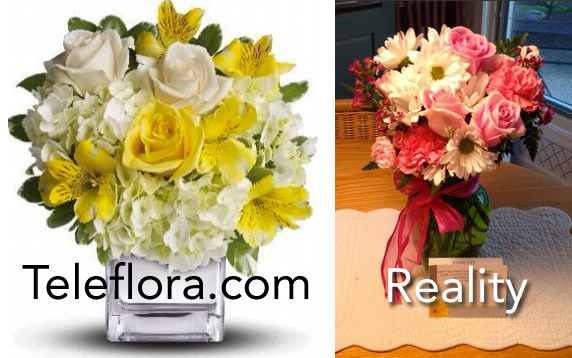Here’s Why Florists’ Websites And Reality Will Never Match Up

No one would choose “Crap.”
A common consumer complaint about flower deliveries is that the arrangements that show up on our loved ones’ doorsteps isn’t as tall or full as the pictures we saw of the arrangement online. A former florist wrote to Consumerist to explain why this is. The photos from FTD, Teleflora, and other Big Flower companies are staged to look nice for the camera, but real-life is three-dimensional.
A former florist wrote to us to explain how this perspective shift works. “Something you said in your story earlier [this week] really hit the nail on the head, though maybe not in the way you think,” reader S. explains. In our post on Wednesday, reader Jason wrote to us to complain that the flowers he had sent to his mother didn’t measure up, even though he had paid extra for a large arrangement. Here are they are side by side:

According to S., yeah, the arrangement was problematic because the flowers were wrong. He ordered roses, and those should have been roses. When it comes to the arrangement’s size, Jason wasn’t ripped off in the way that he thought he was. “This arrangement does measure up…if you somehow pointed all 15 blooms at the camera,” she explains. Real life is three-dimensional, and so are real flower arrangements.
S. continues:
That point is exactly why no one should order from Teleflora, FTD, etc – all of those pretty pictures you see on their websites are arranged in a 2-dimensional layout, with all blooms tilted toward the camera.
It’s deceptive – the photo arrangements are done in a way that implies a “round” arrangement (like a ball sitting on top of a vase) – it’s implied that there are additional flowers that you can’t see.
Once your mom’s local florist sits down to make the arrangement out of the book for, say, Teleflora, he or she isn’t going to make the exact same thing that you saw in the website photo. It will have the same amount of the same type of flowers, but they’ll be arranged in a three-dimensional shape. The photos that florists use to guide them in making the arrangements are not the same ones that the customer sees.
“In every case, that menu states an identical number of stems as are visible in the picture, nothing more (and the cost allotted to the florist reflects this),” S. explains. “Florists know that no one in their right mind wants a 2-dimensional arrangement, so they’ll generally create a smaller 3-dimensional arrangement and hope that the recipient didn’t see the Teleflora picture, so they won’t be disappointed.”
Here’s a great example of what S. is talking about. A disappointed boyfriend ordered flowers from FTD, and sent this picture to us shortly before Valentine’s Day in 2013.

The one on the right looks terrible, mostly because of the shaggy greenery. Count the roses, though. Both arrangements have twelve. It’s just that all twelve are facing the camera on the left, implying a much larger and fuller arrangement.
Once you realize that’s how florist website photos work, you can’t un-see it. We posted this disappointing Mothers’ Day bouquet earlier this week, too.

The colors are wrong, which made the sender unhappy, but the size of the arrangement is correct. It would look exactly like the photo if you bunched all of the flowers together and pointed them in one direction.
Before digital photography and especially before camera phones, the sender would probably never see what flower arrangement a faraway loved one really received. That’s good for keeping florists accountable, but when consumers start with deceptively-arranged photos, we’re holding them accountable to the wrong image.
“When I was working as a florist, we ended up taking a loss on most Teleflora arrangements – we often included more product than Teleflora reimbursed for, just to make things look presentable,” S. explains.
The solution? The ironic thing is that most florists’ sites are based on a template and designs from the big wire services. If you order directly from their site (and not from a fake local florist), the florist gets a bigger share of your money.
Better yet, look for a “Designer’s choice” or “deal of the day” option on the Web ordering form, or call them on the phone. Give them color parameters and the flower types that the recipient likes or doesn’t like, and let the shop work their floral magic.
Of course, there are cases when florists deliver total crap. Misleading website photos are no excuse for late, missing, or terrible arrangements. It’s just great to hear from an insider about how this really works, and why real-life flowers make so many of our readers sad.
RELATED:
Florists Hate FTD And Teleflora Even More Than Disappointed Girlfriends Do
Want more consumer news? Visit our parent organization, Consumer Reports, for the latest on scams, recalls, and other consumer issues.

